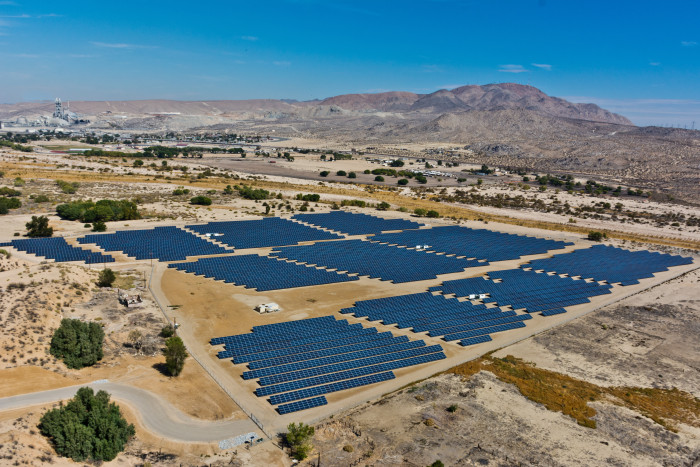SRP courts controversy with new solar plant, policies
Cameron Abbott
Mesa Legend
Ditat Deus, “God enriches.” Arizona’s state motto has led the state’s mentality towards industry for over one hundred years, where Arizona was known for the five C’s: copper, cattle, citrus, cotton, and climate. Climate seems to be the most prevalent,and one thing the Arizona climate excels in is bright and vibrant sunshine. With the alternative energy market surging in the last decade, it only was a matter of time before solar came to Arizona. Salt River Project (SRP), the irrigation municipality that has become the energy giant that controls the greater share of electricity in the greater Phoenix area, has invested heavily into a solar venture known as the Sandstone Solar Plant, which broke ground in July. Nearing completion, the 45 megawatt power plant stands to contribute power throughout Arizona. “The panels have arrived, so they are installing the panels now,” said Patty Garcia-Likens, an SRP media relations representative.

According to Garcia-Likens, that’s just a stepping stone for the company. “SRP’s board created a goal of having 20 percent of our retail energy come from sustainable and renewable energy resources,” she said. “Right now we are at about 14 percent, so with the addition of Sandstone, that will certainly help us be on our way in reaching that goal.” But not everyone is seeing SRP’s actions as entirely beneficial. “Early this year SRP introduced a new solar rate plan that increased the grid access fee for solar customers while also introducing a new monthly demand charge,” said Kyle Ritland, of Sun Valley Solar Solutions, a Chandler based solar panel installation company.
“The new demand charge is calculated per kilowatt and is based on a 30-minute window of time during on-peak weekday hours where your home drew the most energy from the grid above and beyond what your rooftop solar system was producing at the time,” Ritland said. SRP has been strong in the affirmation that what they did was create a price plan for future solar panel customers. “It’s putting our solar customers on a price plan that better fits how they utilize our resources,” Garcia-Likens said. “Those customers who installed panels after Dec. 8, 2015 will be under a different price plan where customers who had solar panels or an application in before that date were grandfathered in.”“This encourages homeowners to make sure their panels are at their most efficient,” she added. But what benefits are there to reap?
Ritland contests that calculating the remaining benefits are improbable. “Because the demand fee has the potential to vary greatly based on a variety of usage scenarios which could occur in a 30-day billing cycle, it’s dramatically more difficult for solar customers to calculate a clear return on their investment,” Ritland said. “In other words, it’s very difficult to guarantee that solar will offset a predetermined percentage of your monthly energy bill when your fees are based on how much energy you may or may not use in any given 30-minute window in the next 30 days.”
“And that’s before you start factoring variables such as weather, which can impact the performance of your solar array,” he added. “What if a cloud passes by in the critical timeframe?”
Ritland’s comments hold true for the industry it would seem, as SolarCity, the Elon Musk-chaired solar panel installation giant, has shifted out of the area after the SRP board of directors voted in February to approve the final measure. SolarCity began a moving initiative in April, moving an initial eighty five out of nine hundred employees. SolarCity opted for no comment on the issue. Ritland, however was more blunt. “The net result of this new demand charge has been a dramatic reduction in new rooftop solar sales in SRP territory throughout 2015,” he said. SRP maintains their statement about solar customers needing to pay their fair share of the energy grid, a position that would suggest that homeowners that use solar panels on their home don’t pay fees to maintain the grid and use SRP’s power resources.
This is something that solar companies like SolarCity and Sun Valley Solar Solutions are careful never to stipulate (as it would be false), instead advertising a cost savings as part of an investment to your home. “The thing that is the most compelling about this plant, though, is that this is the lowest price that we’ve been able to get for solar,” Garcia-Likens said. “In the past, solar is something our customers have wanted us to do, it’s something we have wanted to invest in, but we’ve always had to look at it as something we want to invest in, but something we want to make sure that we’re getting the best resources for our money so that it doesn’t impact our customers so much.” “What’s happening now with solar is finally reaching a point where it has been cheaper than it has in the past. And it kind of rivals what we’re paying for our other resources,” Garcia-Likens added. “So it’s very exciting for us to be able to invest in a community scale program that benefits all of our customers.”
In light of SRP’s success, Arizona Public Service Co. attempted to follow suit, but was hit with intense backlash and numerous complaints that caused APS to apply to have its rate increase application removed from the Arizona Corporate Commission, as the government entity in the State of Arizona that regulates business entities. If this is a problem for APS, then wouldn’t the same be said for SRP? Wouldn’t the Arizona Corporate Commission step in? They can’t. The ACC is unable to regulate it as SRP began as an irrigation service, and protected under the Federal Reclamation Act of 1902, making them a quasi-municipality. The ACC has no authority to regulate municipality nor municipality utilities. The virtual monopoly utility companies maintain is suffocating, and with events as they currently are, one thing remains clear.Arizona has solar like Texas has oil, and we have only seen the beginning of things to come for the Valley of the Sun.









